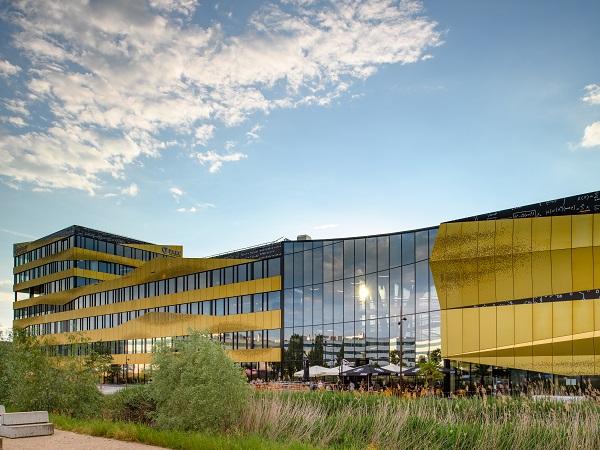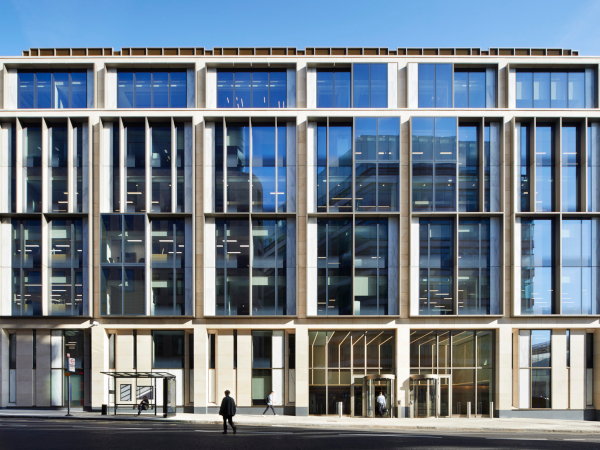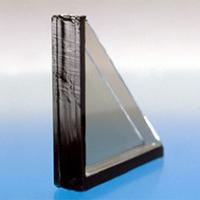
Date: 3 March 2022
With the EXPLORiT, the Y-Parc in Yverdon-les-Bains is gaining a new and multifunctional centre that combines leisure, education, business and a range of services under a single roof. Situated at the heart of the largest science and technology park in Switzerland, this avant-garde new building designed by the Philippe Gilliéron firm of architects is both a local eye-catcher and a magnet for visitors from across the country.
The wing of the building consists of two elements, which are connected via a fully glazed atrium that serves as an access level. The triple insulating glass from Glas Trösch, which incorporates layers for sun protection and thermal insulation, contributes to the high energy efficiency of the building and helps ensure the maximum well-being of visitors.
Playful learning at the science and technology park
Learning through play – this is the underlying concept of EXPLORiT, which is well established in the form of ‘edutainment centres’ at numerous locations across Switzerland. These interactive educational centres are predominantly oriented towards the STEAM learning method (science, technology, engineering, art & mathematics), an educational approach that gives children and adolescents an understanding of the respective disciplines by encouraging independent exploration and experimentation.
The didactic offer encompasses several experience-oriented exhibitions and places of learning such as Kindercity and Sciencity, which can be enjoyed by visitors to EXPLORiT in the Y-Parc Science and Technology Park in Yverdon-les-Bains. In keeping with the spirit of the location, it has also been possible to realise a diverse social infrastructure that benefits the employees of the 200 businesses that operate on site. As well as restaurants, shops and cinemas, these include co-working spaces, maker spaces for start-ups, wellness offers and a broad range of service providers.
An architectural heart of gold
Situated in Switzerland’s largest science and technology park, the new building is not only an architectural landmark but is also its functional heart. The project from the Philippe Gilliéron firm of architects expresses this both in form and cubature as well as in the design of the façade: The 100-metre-long wing of the building is situated in a central location and covers an area of around 14,000 square metres, while its six-storey tower marks the highest point of the entire Y-Parc. The essential allure of the building is also underlined in a more figurative sense – the shimmering gold of the anodised aluminium façade elements can be seen from some distance. Functionally, the project is divided into two main components, connected via a fully glazed atrium that serves as an access level. While one part houses the educational and recreational activities, the other accommodates the shops and offices.
Energy efficiency with a transparent aesthetic
As a place for training young people, the building is geared towards sustainability – a requirement that it is also able to fulfil in terms of energy use. Alongside a solar system on the roof, a standalone network for autonomous power supply and a system for heat recovery, the use of triple insulating glass with the SILVERSTAR EN2Plus thermal insulation layer from Glas Trösch helps ensure that the building meets Minergie P energy efficiency standards.
“The planning of the fully glazed atrium posed a particular challenge,” explains lead architect Mehdi Rouissi. “It was important to us to emphasise the transparent aesthetics of the atrium as a connecting element of both structures, and at the same time meet all of the requirements for heat and sun protection.”
Here, the modern triple-insulating glass scores on three fronts: In the summer, the low solar energy transmission of the SILVERSTAR SUNSTOP Silver 20 T sun protection layer prevents the atrium from overheating, while the SILVERSTAR EN2plus thermal insulation layer ensures low heat losses in the winter. This approach ensures maximum transparency for the atrium, with no need for roller shutters. Thirdly, overall energy consumption and CO2 emissions are kept to a minimum thanks to the low heating and cooling requirements.
 600450
600450


























Add new comment